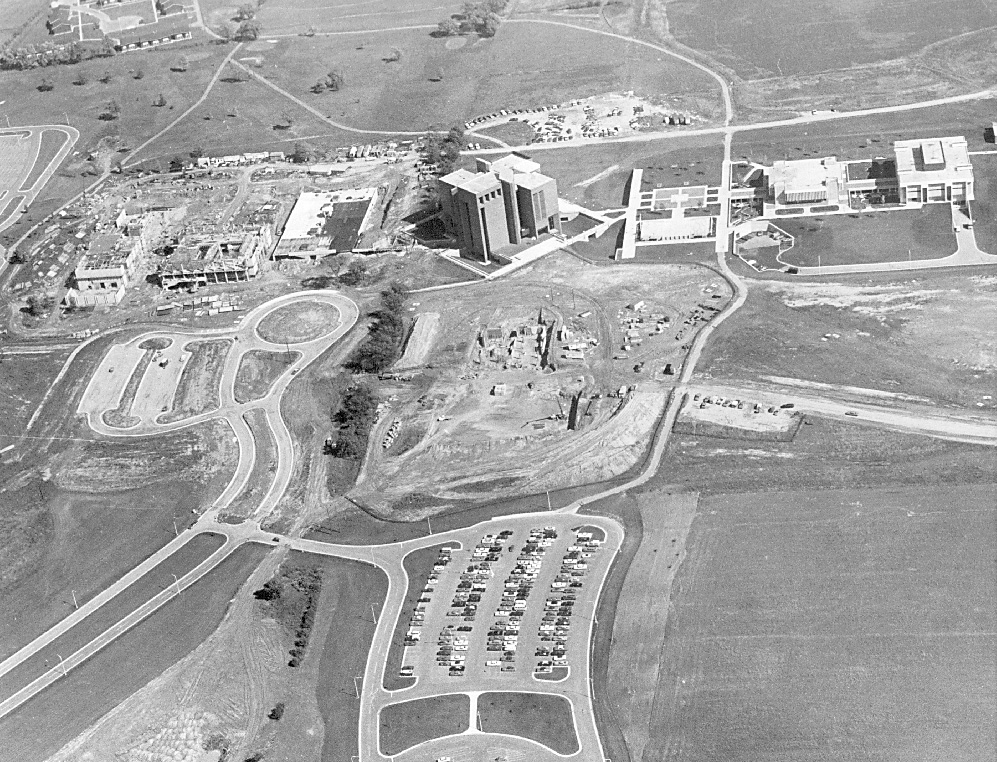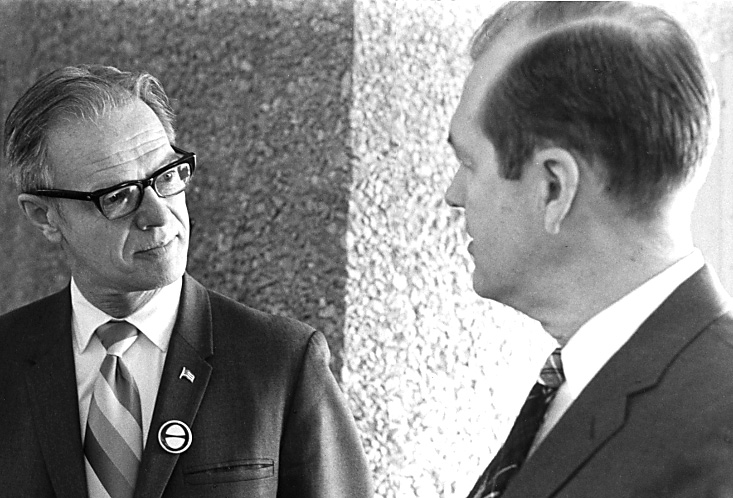Chapter Six: 1972—1973
“Most of the news that trickles out of the University of Wisconsin-Green Bay these days is good news—the kind that university officials love to talk about.... Enrollment is at an all-time high and is running comparatively better than at most schools in the UW System. Building plans are on schedule and the campus, sometimes referred to as a ‘concrete jungle’ or ‘sterile,’ is beginning to take shape.”
- Reporter Tony Walter in the Press-Gazette, Oct. 4, 1972
The euphoria reflected in Walter's interview feature echoed the tone of Chancellor Weidner's address a month earlier at the faculty-staff breakfast. A month earlier the same optimism pervaded a report prepared for the annual community appreciation dinner and distributed widely after the event. Encouraging enrollment figures were a major reason for Weidner's characterization of the season as “the smoothest fall I can remember.” But other factors contributed to a generally rosy picture.
After 45 months of improvising and three major moves, the library was open in its permanent home at the center of the campus. The University's top administrators—previously scattered in quarters from the bay shore to the golf course—were assembled on the eighth floor of the building; faculty members gathered from even more distant points occupied offices on the seventh floor. The three buildings of the College of Creative Communication were taking shape north of the library, with a completion date less than a year away. To the west, walls were rising for the College of Community Sciences buildings, the fourth major construction project to be initiated in five years.
The undergraduate curriculum was largely in place. Reorganization of the School of Professional Studies, academic home for more than 400 students, would constitute the only major change in the academic structure during the year. The business administration program had received a new name, managerial systems, and promotion to the status of concentration. Professors and administrators of an examining team from the North Central Association of Colleges and Universities studied the academic program and visited the campus. They liked what they saw. In granting UW-Green Bay full accreditation to grant baccalaureate degrees as an institution operationally separate from Madison, they took particular notice of the high morale of the student body.

UW-Green Bay campus, fall 1972.
Faculty members, students and citizens were helping to fulfill Weidner's vision of “communiversity,” described by the chancellor as “a symbiotic relationship between the University and community, of benefit to both.” Studies of air quality, solid waste disposal and noise pollution, and internships in community agencies—carried out under the liberal education seminars program—were only part of the story. Thirty new volunteers, including the first black and Indian students, were learning and earning in the second year of the University Year for Action program. One UYA team helped to organize a school for Menominee Indian children. Another founded a free medical clinic for low-income families in Green Bay.
Outreach to the community was expanding in many directions and to all age groups.
Members of the environmental sciences faculty hosted science teachers and students from 24 Wisconsin high schools at a one-day workshop on air quality. A summer event brought 84 senior Girl Scouts, Boy Scouts and adult leaders from 15 states to the campus for a week to gain “ecological understanding for quality living.” When administrators threw a party to honor construction workers employed on the campus, more than 200 “hard hats” turned out for an evening of bluegrass music, refreshments and socializing. Public television came to Northeastern Wisconsin with the inauguration of WPNE-TV, Channel 38, as the first operating unit of a new state educational television network. The station, located on the campus, was developed and equipped with funds from a $386,000 HEW grant.
Fall semester students were the first to have access to university-sponsored child care. After two years of study, planning and campaigning by a committee primarily of faculty wives, a cooperative day care center opened for 41 toddlers. Financed by student fees and gifts from the University League, an organization of campus and community women, the center at first operated in vacated quarters of a county nursing home. Ten weeks later the enterprise moved to a refurbished house near the campus entrance.
The University's first guest auditors, men and women aged 60 and older, were invited to audit courses of their choice without paying fees. The program was instituted by Marge Engelman, newly appointed director of adult education. The first venture of its kind in the UW System, it was soon picked up by other campuses including UW-Madison.
Engelman garnered private funds to support scholarships for returning adult students; she also established new off-campus learning centers outside Green Bay and expanded opportunities at the Wisconsin State Reformatory. Commuting professors presided over five evening courses at Sturgeon Bay High School; in Shawano, students gathered at a downtown bank for a three-credit survey of Shakespeare's works. English, world literature and social psychology were among the offerings at the reformatory.
Increasingly, the traffic also moved from community to campus. Mayor Donald Tilleman, serving his third consecutive term, led the procession. An enthusiastic University supporter from his first day in office, he was invited by students to open a series of leaders-in-residence gatherings for lunch and informal conversation.
“He loved the campus, and he would drop in on Chancellor Weidner whenever he could,” Marjorie Fermanich remembered. She spoke of a particularly memorable visit on Weidner's birthday when the chancellor's office was still located in a house at the bottom of a hill. The mayor rolled down the hill in a squad car—“siren screaming, lights flashing and bubble turning”—and emerged carrying a birthday cake. Tilleman died in November 1972 after a heart attack. At a memorial service on the campus, Weidner eulogized him as “the best friend the University had.” To UW-Green Bay, Weidner said, Mayor Tilleman was “a founding father, a wise counselor and a warm friend.”
Sixteen residents of Green Bay, Neenah, Marinette and Sturgeon Bay were appointed by the regents to the first UW-Green Bay Visiting Committee, forerunner of the campus Board of Visitors. Meeting quarterly, they were charged to examine and advise on the work of the University in the role of a “sympathetic but independent” monitor.

Donald Tilleman and Edward Weidner
The University was gaining visibility, too, with larger segments of the adult population.
Early in the year sports fans filled the Brown County arena to watch the men's basketball team wrap up a second straight season of 20-plus victories. Others were attracted to University-sponsored educational and cultural events arranged by Thomas Birmingham. In the absence of a real theater, Birmingham booked visiting artists and lecturers into the auditorium of the Environmental Sciences Building or the Preble High School assembly hall. Television personality Hugh Downs and radio humorist Henry Morgan were among the national celebrities who came to town under University auspices. Voices, Inc., a troupe of black singers and dancers, portrayed the journey of their brothers and sisters from African village to urban ghetto. The all-Indian White Roots of Peace ensemble highlighted a celebration of Indian Culture Awareness Day. At Preble, major attractions included organist Virgil Fox and a lavish Mikado by the Skylight Theatre of Milwaukee. When the junior high school music clinic moved to the bay shore campus for its seventh summer program, the University welcomed hundreds of parents to a closing concert on the library plaza. For many, the event marked their first trip to the University.
The academic program continued to win attention from newspapers and magazines around the country and abroad. Parade, a Sunday newspaper supplement distributed nationally, trumpeted the involvement of students and faculty members in community projects, including a cleanup of the wildlife sanctuary at Bay Beach. Other features were carried in publications ranging from a magazine placed each month in 120 motels nationwide to a newspaper in Johannesburg, South Africa. The University also made the pages of Readers Digest with a 200-word segment in an article on “A College Education: Exciting New Ways to Get One.” The complete piece had first appeared in the national Kiwanis Magazine.
Weidner, meanwhile, was collecting honors of his own. Soon after he accepted the post of secretary of the American Council on Education, Weidner was tapped by HEW Secretary Elliott Richardson for service on the National Council on Environmental Education. Weidner traveled to Spain to present an invited paper on interdisciplinarity at the Universidad de Santiago and stayed on to meet with a task force planning a new university elsewhere in the country. At home, Weidner regularly received educators arriving from overseas to see at first hand the work of the institution they had been reading about. The planning committee for Athabasca University in Canada came three times; a growing list of other delegations included visitors from France, Germany, Jordan, Saudi Arabia, Ethiopia, New Zealand and Australia.
Amid all the portents of continuing success, however, even Weidner felt obliged to temper his optimism. Addressing the University community at the beginning of the 1972-73 year, he voiced his concern over the unfinished business of merger.
“We are devoting ourselves to the task of making certain that the condition of the merger bill—namely, that it should promote diversity of opportunity in Wisconsin—will come to pass, and that UW-Green Bay will be a good example of it.” Stay away from UW System committees, he cautioned his colleagues. To protect campus autonomy, “we are going to have to be ever watchful ... and keep policy making on a campus basis as it is at the present time.” While extolling the numbers, the quality and diversity of the student body, he admitted that “enrollment did not increase as much as we thought it might this fall.” Even with substantial gains from outside the area, the final total of 3,625 students fell significantly short of a system projection of 4,200. In an October 1972 interview with Tony Walter of the Press-Gazette, Weidner offered some explanations.
“You have to consider what the rest of the country is doing,” he said, noting that Green Bay was one of only four UW units to show even a small increase in enrollment over the previous fall. Weidner cited “a national campaign saying that college education is unnecessary,” the job pinch, the sputtering national economy, and the end of the military draft. “Predicting enrollments is not a science, it's a guess,” he said.“ We still have a chance of getting to around 6,000 by 1977, but we're not panicking.”
For all the encouraging words from the chancellor's office, one fact remained: After an initial surge of local enrollment in response to pent-up demand, the University was falling behind in its own backyard. Between 1968 and 1972, despite huge gains in veterans and over-25 adults, the proportion of Brown County students had declined from 79.9 percent to 58 percent of total enrollment. And along with information about the year's accomplishments, the Office of News and Publications was turning out feature stories about local graduates who had succeeded in finding jobs in their chosen fields. Admissions counselors, meanwhile, pondered a question they were asking themselves for the first time: Is “recruiting” really a dirty word?